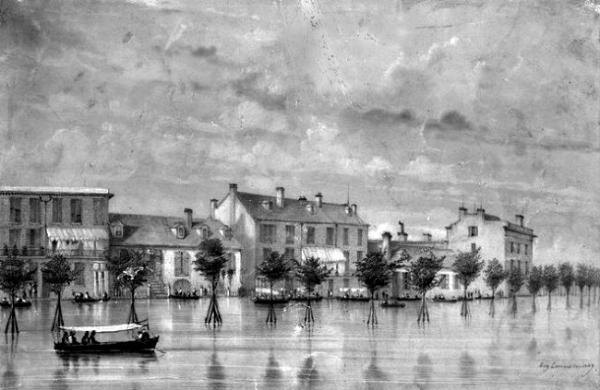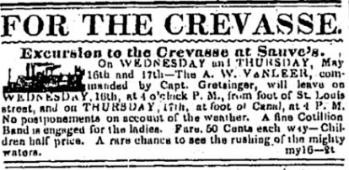| Image credit: Infrogmation@Wikimedia.Commons The link to this page is: http://old-new-orleans.com/NO_Sauve_Crevasse.html Back to Old New Orleans Whispers - Home |
| Pierre Sauvé owned a sugar plantation on the Mississippi River seventeen miles above New Orleans, in what is now River Ridge, Jefferson Parish, LA. On May 3, 1849, the levee at the Sauvé plantation gave way. Initially, there was hope that the flood wouldn't reach the city, but, by May 15th, water was lapping at Rampart Street. A levee along the lower bank of the Carondelet Canal protected Faubourgs Marigny and St. John and other areas below the canal, but Uptown and the Central Business District didn't fare as well. The water kept coming and all efforts to close the crevasse proved unsuccessful. Finally, on June 20, engineers Dunbar and Surgi managed to stop the flow. The famous Mississippi River flood of 1927 would have undoubtedly wreaked havoc on New Orleans, as it did on so many other places that year, but an artificial crevasse was created down river to save the city. Therefore, the Sauvé Crevasse of 1849 is notable because it was the last flooding New Orleans experienced directly from the Mississippi River. -- Nancy |

| Sauvé Crevasse |

| Flooding on Canal Street caused by the Sauve Crevasse, painted in 1849 by Elizabeth Lamoisse |
| Newspaper ad, May, 1849: "Excursion to the Crevasse at Sauvé's ~ On Wednesday and Thursday, May 16th and 17th -- The A. W. Vanleer, commanded by Capt. Gretainger, will leave on Wednesday, 16th at 4:00 o'clock p.m., from foot of St. Louis Street and on Thursday, 17th, at foot of Canal, at 4 p.m. No postponements on account of the weather. A fine Cotillion Band is engaged for the ladies. Fare 50 Cents each way -- Children half price. A rare chance to see the rushing of the mighty waters." |